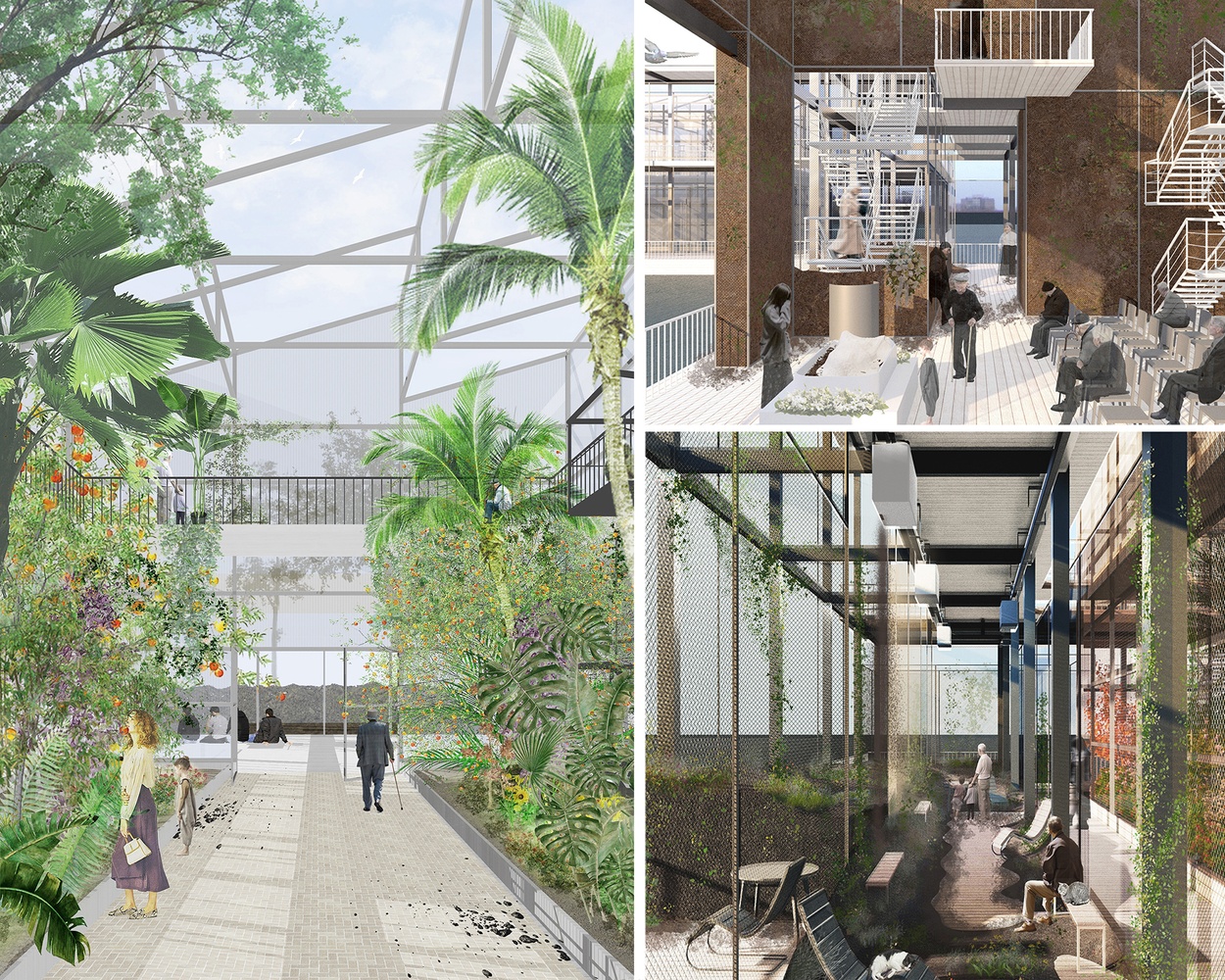Overpass re-establishes a relationship between land and life. Due to the rapid development of the global economy and increasing political and environmental hostility, migration has been pervasive throughout the last century. With a profound history of global immigration, New York has yet to sufficiently recognize the extent of loss of identity, community and belonging among migrants. At the same time, with an augmenting shortage of spaces to commemorate the deceased, New York lacks sustainable, ethical and economic procedures for migrants and their relatives to settle their death. Addressing the sorrow and grief of death within a displaced environment and culture, the project provides an alternative form of belonging and reinstates lost kinship for the deceased migrant. The sustainable and transformative infrastructure of human composting transcends the significance of the soul to provide families a meaningful way of memorizing the dead by transitioning the human body into soil. Islands juxtaposed with “sacred” climatized green spaces and mourning passages utilize the soil to nurture other living species and accumulate through time, slowly modifying the occupiable architectural spaces. Cultivated climate regimes correlate with the temperature and moisture of global ecological regions, providing immersive habitat for flora that are familiar and meaningful to migrants’ homelands, while also connecting individuals across diverse geographies. The continuous accumulation, integration and deterioration of soil returns migrants of New York back to the land and beyond, reconnecting the migrated, the city, and distant relatives. The initial project occupies a site adjacent to the Ellis Island Immigration Museum to celebrate the existence, importance, and dedication of immigrants to New York City. New clustering facilities will expand gradually to locations along New York’s shoreline according to the population and needs of immigrant communities.
A
AIA CES Credits
AV Office
321M Fayerweather Hall
Abstract Publication
415 Avery Hall
Academic Affairs
400 Avery Hall
Academic Calendar, Columbia University
Academic Calendar, GSAPP
Admissions Office
407 Avery Hall
1172 Amsterdam Avenue
New York, New York 10027
Advanced Standing Waiver Form
Must be printed and returned to 400 Avery Hall
Alumni Board
Alumni Office
405 Avery Hall
1172 Amsterdam Avenue
New York, New York 10027
Architecture Studio Lottery
Assistantships
Avery Library
300 Avery Hall
1172 Amsterdam Avenue
New York, NY 10027
Avery Review
Avery Shorts
B
Black Student Alliance at Columbia GSAPP
Building Science & Technology Waivers
Bulletin Archive
C
Career Services
300M Avery Hall
Columbia Books on Architecture and the City
Commencement
Communications Office
415 Avery Hall
Conversations podcast
Counseling and Psychological Services
Courses
Credentials Verification
Credit Transfer
Cross Registration
D
Dean’s Letter
Dean’s Office
402 Avery Hall
1172 Amsterdam Avenue
New York, NY 10027
Development Office
404 Avery Hall
Directory of Classes (All Columbia University)
Disability Services
Dodge Fitness Center
3030 Broadway Dodge
Dual Degree Program Requirements
E
End of Year Show
Events Office
415 Avery Hall
External Funding Sources
F
Faculty Directory
Feedback
Finance Office
406 Avery Hall
Fitch Colloquium
Future Anterior Journal
G
GSAPP Community Fellowship Program
GSAPP Emergency Fund
GSAPPX+
Grades
Graduation
Graphics Project
H
Honor System
Human Resources
Hybrid Pedagogy Resources
I
IT Helpdesk Ticket, GSAPP
IT Office, GSAPP
IT, Columbia University (CUIT)
Identity
Incubator Prize
International Students and Scholars Office (ISSO)
N
News and Press Releases
Newsletter Sign Up
Non-Discrimination Statement and Policy
O
Onera Prize for Historic Preservation
Online Admissions Application
GSAPP Admissions 407 Avery Hall
Output Shop
116 Avery Hall
1172 Amsterdam Avenue
New York, NY 10027
Ownership of Student Work Policy
P
Paris Prize, Buell Center
Paul S. Byard Memorial Lecture Series
Percival & Naomi Goodman Fellowship
Plagiarism Policy
Policies & Resources
Press Releases
Publications Office
415 Avery Hall
1172 Amsterdam Avenue
New York, New York 10027
R
Registration
Registration: Add / Drop Form
Room Reservations
S
STEM Designation
Satisfactory Academic Progress
Scholarships
Skill Trails
Student Affairs
400 Avery Hall
Student Awards
Student Conduct
Student Council (All Programs)
Student Financial Services
Student Health Services at Columbia
Student Organization Handbook
Student Organizations
Student Services Center
205 Kent Hall
Student Services Online (SSOL)
Student Work Online
Studio Culture Policy
Studio Procedures
Summer Workshops
Support GSAPP
Overpass: a Cemetery of the Distant






